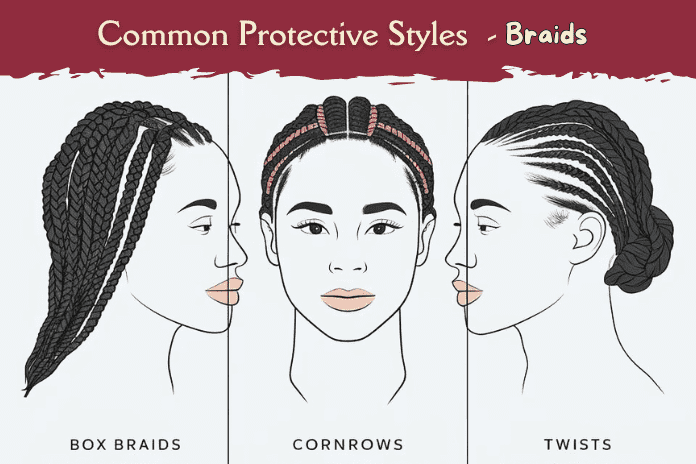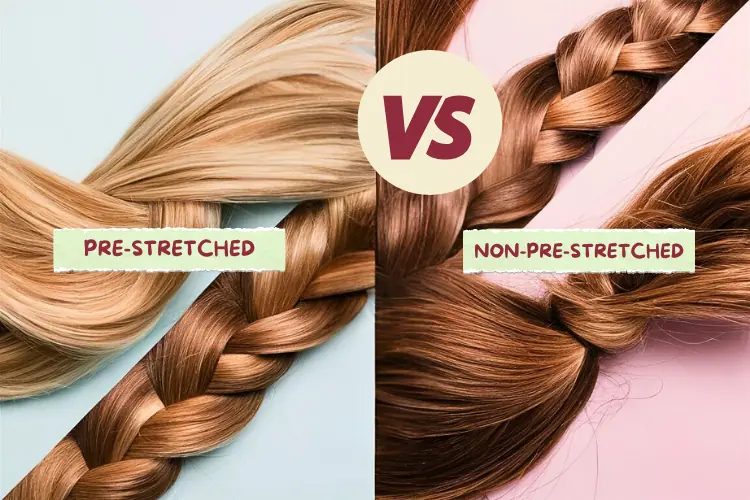You know that feeling of hair exhaustion after a week of constant styling? It’s real. And it’s one of the main reasons why protective styles have become a go-to solution for many of us. Protective styles like braids, twists, buns, and wigs not only offer a break from daily hair manipulation but also shield our tresses from environmental damage. And if you’re anything like me, always on the lookout for ways to keep your hair healthy while looking fabulous, then this guide is for you.
What Are Protective Styles?
Protective styles are hairstyles designed to safeguard your hair by tucking away the ends and reducing exposure to environmental stressors. Think of them as a cozy blanket for your hair, protecting it from breakage and damage. Popular protective styles include box braids, cornrows, twists, and buns. And let’s not forget the versatility and flair that wigs and weaves bring to the table.
The Benefits of Protective Styles for Hair Health and Growth
Let me share a story about my friend Naomi. Naomi has been rocking braids for years, and her journey with protective styles has significantly shaped her understanding of hair care. She used to struggle with breakage and dryness, but since embracing protective styles, she’s noticed a dramatic improvement in her hair’s health and length. Her personal experiences highlight the tangible benefits of these styles.
Prevention of Breakage
When you reduce the amount of daily styling, you naturally cut down on breakage. Protective styles keep your hair intact, minimizing the risk of snapping strands due to constant manipulation. Naomi swears by her braids for this very reason. She noticed that her hair retained more length and strength once she started incorporating protective styles into her routine.
However, if these styles are not maintained properly or are too tight, they can potentially lead to breakage or traction alopecia. It’s important to ensure that protective styles are installed and maintained correctly to avoid damage.
Moisture Retention
Protective styles play a vital role in moisture retention. They help lock in moisture, which is crucial for maintaining elasticity and preventing that dreaded dryness. When your hair is tucked away in braids or twists, it’s better able to retain the hydration from your favorite leave-in conditioners and oils.
Encouragement of Growth
With reduced breakage and better moisture retention, protective styles can promote healthier hair growth environment over time. When your hair isn’t constantly breaking, it has the chance to grow longer and stronger.
Types of Protective Styles
Common Protective Styles
Braids

- Box Braids: These are the go-to for many. Individual sections of hair are braided, often with extensions to add length. They can be styled in countless ways and suit different hair types.
- Cornrows: Tight braids that lie flat against the scalp, often styled in intricate patterns. They’re low-maintenance and can last for weeks.
- Twists: Two strands of hair twisted together, either with natural hair or extensions. Twists are less tension-inducing than braids and can be styled in various ways.
Buns and Updos
- Benefits of Tucking Hair Away: Styles like buns protect your hair from environmental damage while giving you a polished look. They work for both casual and formal occasions.
- Types of Buns: Options include messy buns, sleek buns, and top knots, each offering different aesthetics while protecting your hair.
Wigs and Weaves
- Versatility and Protection: Wigs allow for complete coverage of natural hair, enabling you to change styles frequently without manipulating your natural hair. Weaves can also provide length and volume while protecting the natural hair underneath.
Characteristics of Effective Protective Styles
Styles that require minimal daily handling help prevent breakage and stress on the hair. This is especially crucial for those with textured hair, who are more prone to damage.
A good protective style should allow your hair to retain moisture. This can be achieved through proper hair care routines, including using leave-in conditioners and oils.
Protective styles shield your hair from harsh weather conditions, UV rays, and pollutants. This is particularly important if you live in an area with extreme weather.
Pre-Stretched vs. Non-Pre-Stretched Hair
Differences in Hair Types
- Weight and Texture: Pre-stretched hair is lighter and more manageable, while non-pre-stretched hair tends to be heavier and coarser, which can lead to discomfort and potential headaches.
- Impact on Scalp and Hair Health: Heavier hair can cause tension on the scalp, leading to pain and possible hair loss over time. The texture of the hair can also affect how well it blends with natural hair.
Ease of Maintenance
- Knotting and Frizz Issues: Non-pre-stretched hair is more prone to tangling and frizz, making it difficult to maintain over time. Pre-stretched hair, on the other hand, is designed to be smoother and easier to manage, reducing the need for constant detangling.
- Time Taken for Braiding: Using pre-stretched hair significantly reduces the time spent on braiding, which is beneficial for both the stylist and the client. This can lead to lower costs for salon services due to reduced labor time.
And yes, some people might prefer non-pre-stretched hair for specific styling purposes, even if it generally has more maintenance needs, so remember.
Personal Experience with Different Hair Types
Naomi reflects on her experiences with different types of hair, sharing specific instances. She kept hair from a previous braiding session and compared it to her current style, noting significant differences in weight and texture. She recalls experiencing headaches and discomfort with non-pre-stretched hair due to its heavy weight. These personal highlights underscore the real-world consequences of using the wrong type of hair.
Specific Brands and Types of Hair Used
Naomi provides a thorough description of Rasta Free and FreeTress hair types, including packaging, weight, and texture. This level of detail helps readers visualize the differences between pre-stretched and non-pre-stretched hair, making it easier for them to make informed decisions.
Comparison of Hair Usage Between Styles
Interestingly, Naomi used fewer packs of pre-stretched hair for her current style compared to her previous non-pre-stretched style, despite having smaller braids. This suggests that pre-stretched hair is more efficient and cost-effective.
Benefits of Pre-Stretched Hair
Advantages Over Non-Pre-Stretched Hair
Lightweight Nature
- Reduced Strain on Scalp: The lighter weight minimizes tension on the scalp, making it more comfortable to wear. This is particularly important for individuals with sensitive scalps.
- Prevention of Headaches: Naomi reports fewer headaches and discomfort with pre-stretched hair. This can enhance the overall experience of wearing protective styles.
Smoothness and Manageability
- Less Tangling and Frizz: Pre-stretched hair is made to be tangle-free, resulting in a smoother finish that requires less maintenance. This quality can save time in daily hair care routines.
- Enhanced Appearance of Braids: The smoother texture contributes to a more polished look, which can boost confidence and garner compliments. Well-maintained braids can enhance your overall appearance and style.
Long-Term Effects on Hair Health
Using lighter, smoother hair can help prevent damage to the natural hair, allowing it to grow healthier over time. This is crucial for individuals aiming to grow their hair long and strong.
Pre-stretched hair can help maintain moisture levels in the natural hair, reducing dryness and brittleness that often lead to breakage. Incorporating moisturizing products during installation and maintenance can enhance this benefit.
Tips for Choosing and Caring for Protective Styles
Selecting the Right Hair
- Importance of Pre-Stretched Hair: Pre-stretched hair is a better choice for those looking to maintain comfort and hair health during protective styling. This can lead to a more enjoyable experience and better results.
- Recommendations for Brands and Types: Naomi recommends Rasta Free and FreeTress based on her personal experience. Highlighting the qualities that make these brands stand out can guide readers in their selection process.
Maintenance of Protective Styles
Encourage a routine that includes washing and moisturizing the scalp and braids to prevent buildup and maintain hair health. Use sulfate-free shampoos and lightweight leave-in conditioners.
Suggesting the use of satin bonnets or pillowcases to minimize friction and preserve the style while sleeping. This simple step can significantly enhance the longevity of the hairstyle.
Conclusion
Protective styles are more than just a trend; they are a vital part of maintaining hair health and promoting growth. By reducing manipulation, retaining moisture, and shielding hair from environmental damage, these styles offer numerous benefits. Whether you choose braids, twists, buns, or wigs, the key is to find what works best for you.
Now, I’d love to hear from you! What is your go-to protective styles? Have you tried pre-stretched hair, and how did it compare to non-pre-stretched options? Share your experiences in the comments below.

